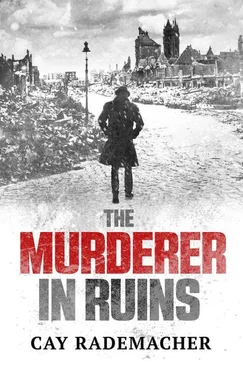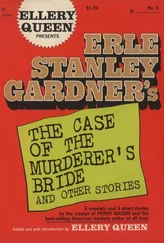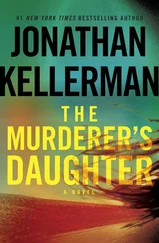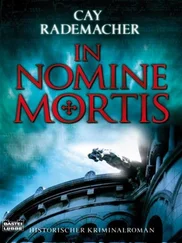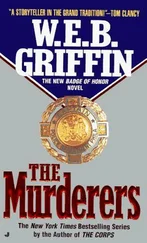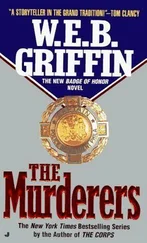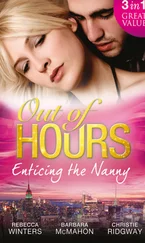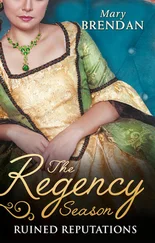Cay Rademacher - The Murderer in Ruins
Здесь есть возможность читать онлайн «Cay Rademacher - The Murderer in Ruins» весь текст электронной книги совершенно бесплатно (целиком полную версию без сокращений). В некоторых случаях можно слушать аудио, скачать через торрент в формате fb2 и присутствует краткое содержание. Год выпуска: 2015, ISBN: 2015, Издательство: Arcadia Books Limited, Жанр: Триллер, на английском языке. Описание произведения, (предисловие) а так же отзывы посетителей доступны на портале библиотеки ЛибКат.
- Название:The Murderer in Ruins
- Автор:
- Издательство:Arcadia Books Limited
- Жанр:
- Год:2015
- ISBN:9781910050750
- Рейтинг книги:5 / 5. Голосов: 1
-
Избранное:Добавить в избранное
- Отзывы:
-
Ваша оценка:
- 100
- 1
- 2
- 3
- 4
- 5
The Murderer in Ruins: краткое содержание, описание и аннотация
Предлагаем к чтению аннотацию, описание, краткое содержание или предисловие (зависит от того, что написал сам автор книги «The Murderer in Ruins»). Если вы не нашли необходимую информацию о книге — напишите в комментариях, мы постараемся отыскать её.
The Murderer in Ruins — читать онлайн бесплатно полную книгу (весь текст) целиком
Ниже представлен текст книги, разбитый по страницам. Система сохранения места последней прочитанной страницы, позволяет с удобством читать онлайн бесплатно книгу «The Murderer in Ruins», без необходимости каждый раз заново искать на чём Вы остановились. Поставьте закладку, и сможете в любой момент перейти на страницу, на которой закончили чтение.
Интервал:
Закладка:
Interrogation was probably the wrong word. They were going to a children’s home. He had a police photo of a murdered girl in his coat pocket. Should he even show it to the children? Children whose parents had been gassed, or their school friends shot dead, or their houses bombed? Should he just show it to the warden? But did he know all his charges well enough to recognise one of them from a police photo?
He looked around. To their left the thick ice on the Elbe sparkled in the morning light, as rough and flat as a slab of concrete. A few small ships, freighters and fishing boats were frozen in alongside the ruined piers. The superstructures of two sunk steamers reared out of the ice. Cranes leant low, half toppled over. Two men, bent double and wrapped in overcoats and blankets, crossed the ice from the Hamburg side walking into the brutal wind.
‘Why do I need a British permit to visit a children’s home?’ Stave asked, partly out of curiosity, partly just to break the awkward silence.
MacDonald was quick to answer, obviously pleased to have something to talk about. ‘The home’s official name is the Warburg Children’s Health Home, in English. It is located in a villa belonging to Eric Warburg, the man who founded it.’
Stave nodded. ‘The banker? The one who emigrated?’
‘To the USA. In 1938. After the war he came back, and it now belongs to him again. Its main purpose is to help Jewish children, mostly concentration camp survivors. Many lost more or less their entire families. They come from various countries. Here in Blankenese they are nursed, given decent food and schooling. The institution is under the particular care of the Occupation Authorities.’
‘Have you spoken to any of the people there?’
‘On the telephone, this morning. I let them know why we were coming, but not in too much detail. The female teacher I spoke to had in any case heard that a child had been murdered. Things like that get around town fast. She’d already seen the police posters of the two previous victims. They’re all over the place. But in Blankenese no child of that age has gone missing.’
‘Why are we even bothering to go out there, then?’ Maschke said.
‘If the murdered girl had ever been in a concentration camp then we might find somebody who knew her,’ Stave explained.
They turned into Kosterberg Strasse, a narrow, cobbled lane leading uphill, bordered on either side with hedges, behind which they could see villa roofs sparkling with frost. At the top of the hill was a huge, yellow-painted castle with tall windows in the midst of a meadow. It turned out to be just the city water works, a relic of long-gone days of extravagance and plenty, when they even built stately homes for pumping machinery.
The entrance to house number 60 was opposite. High hedges and wrought-iron gates that hung on yellow-painted pillars. A young man opened one of the heavy gates when he saw the jeep. The drive was raked gravel. Behind a huge bare oak tree stood a villa from the wealthy mid-nineteenth century, with windows round as bullseyes in the upper storeys.
Children peering out from behind the windows with inquisitive looks. A woman at the door, aged about 30, with short black hair, in a grey woollen overcoat, welcomed Stave and Maschke as if they were tabby cats.
‘I’d prefer it if you don’t pull out your ID cards,’ she said to Stave. ‘It can bring back unfortunate memories.’
Strange choice of words, Stave thought. Odd accent too. He considered and then dismissed shaking her hand, and gave her a slight bow instead. MacDonald gave her a casual wave.
‘My name is Therese Dubois. I was the one you spoke with this morning, Lieutenant. I’ve been given instructions to help as much as I can with your business.’
Camp inmate, Stave guessed. Probably French. Maybe Alsace. Lots of French – mainly Jews or resistance fighters – were taken to Bergen-Belsen. Or Ravensbruck. He recalled the trial going on in the Curio House. Ehrlich probably knows her. He didn’t bother to ask who had given her ‘instructions’.
‘I’m sorry to have to turn up here under such unpleasant circumstances,’ he said at last. ‘I will try to keep our visit as brief as possible.’
‘Please come in,’ Therese Dubois told them, leading them through to a glassed-in, heated veranda, with wicker chairs and rubber plants in big ceramic pots. Stave had to stop himself staring – it had been years since he’d seen houseplants.
He explained why he was there, mentioning the other two murders also. Then he cleared his throat and took out the photo.
The teacher looked at it. Her face turned paler, but she studied it attentively. Then she shook her head. ‘I’ve never come across this poor creature. I’m quite sure of it. She’s not one of ours.’
Stave was silent for a few moments, drumming nervously with his fingers on the arm of the wicker chair, then realised what he was doing and folded his hands. ‘Do you think any of your children might have known her? Perhaps gone to school with her?’
‘You want to show this photo to the children?’
‘If it helps me to find whoever murdered this one, then yes.’
Therese Dubois leaned back in her chair and thought. ‘We currently have 30 children in the home,’ she said quietly. ‘Some of them are just two years old. They never leave here. Those of school age are taught here, not in German schools.’ The tone of her voice suggested those schools were prison camps.
‘At present we do have two children who are allowed to go out, to do errands, go on trips or just to play, although of course it’s been too cold for that of late. I’ll call them.’
‘And may I show them the photo?’
‘They’ve both seen more dead children than you have, Chief Inspector.’
She left the room and came back shortly with a girl and a boy, both of whom Stave guessed to be about 15.
Therese Dubois introduced them as Leonore and Jules. The pair stood shyly in the middle of the room.
Stave smiled, MacDonald nodded encouragingly, Maschke coughed and got to his feet.
‘I’d like to smoke if you don’t mind,’ he said.
Stave nodded and Maschke disappeared out into the park. Before long the bare oak trees were being treated to the smoke from an English cigarette. Stave had no problems with that: the fewer adults these children had to face, the better. And Maschke’s cynical comments were the last thing he needed right now.
He calmly explained to the children why he was here. Therese Dubois translated for the boy, whispering in French. The girl seemed to understand him.
Then Stave showed them the photo.
Leonore and Jules stared at it. There was pity written all over the girl’s face, clinical interest on the boy’s. But even before they said anything, the chief inspector knew what their answer would be.
‘I’ve never seen this girl,’ Leonore said, quite certain. Her accent was thick, from way out in the east, Stave guessed. Galicia maybe.3
‘Non, je n’ai jamais vu cette fille, ’ Jules mumbled. Nobody needed a translation.
Stave put the photo back into his coat pocket, disappointed on the one hand that once again he had had no luck, relieved on the other that he no longer had to hold the photo beneath the children’s noses.
‘Has either of you ever been down to that part of the port, the Bille canal, to gather coal?’ Stave asked them.
‘Our children have no need to go looking for coal,’ Therese Dubois said under her breath, clearly shocked. Stave ignored her.
Leonore smiled uncertainly and, Stave thought, a bit enviously. ‘Never been there, it’s too far.’
The teacher sighed and translated the question into French, drumming in irritation with her fingers. Jules smiled the smile of a boy who’d been out of the home a lot more than the grown-ups knew. But he shook his head too.
Читать дальшеИнтервал:
Закладка:
Похожие книги на «The Murderer in Ruins»
Представляем Вашему вниманию похожие книги на «The Murderer in Ruins» списком для выбора. Мы отобрали схожую по названию и смыслу литературу в надежде предоставить читателям больше вариантов отыскать новые, интересные, ещё непрочитанные произведения.
Обсуждение, отзывы о книге «The Murderer in Ruins» и просто собственные мнения читателей. Оставьте ваши комментарии, напишите, что Вы думаете о произведении, его смысле или главных героях. Укажите что конкретно понравилось, а что нет, и почему Вы так считаете.
